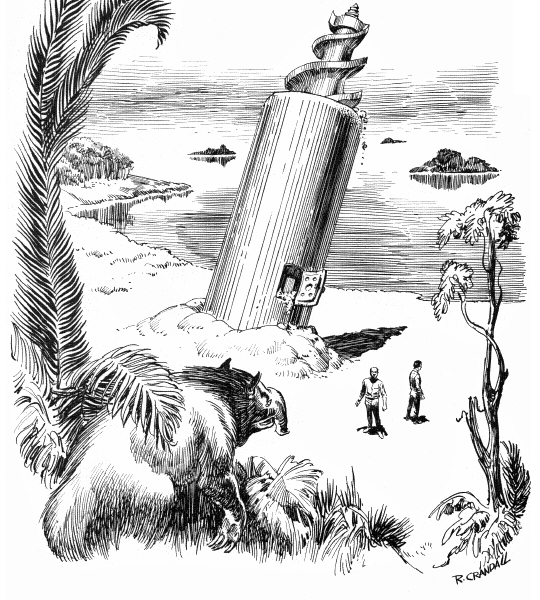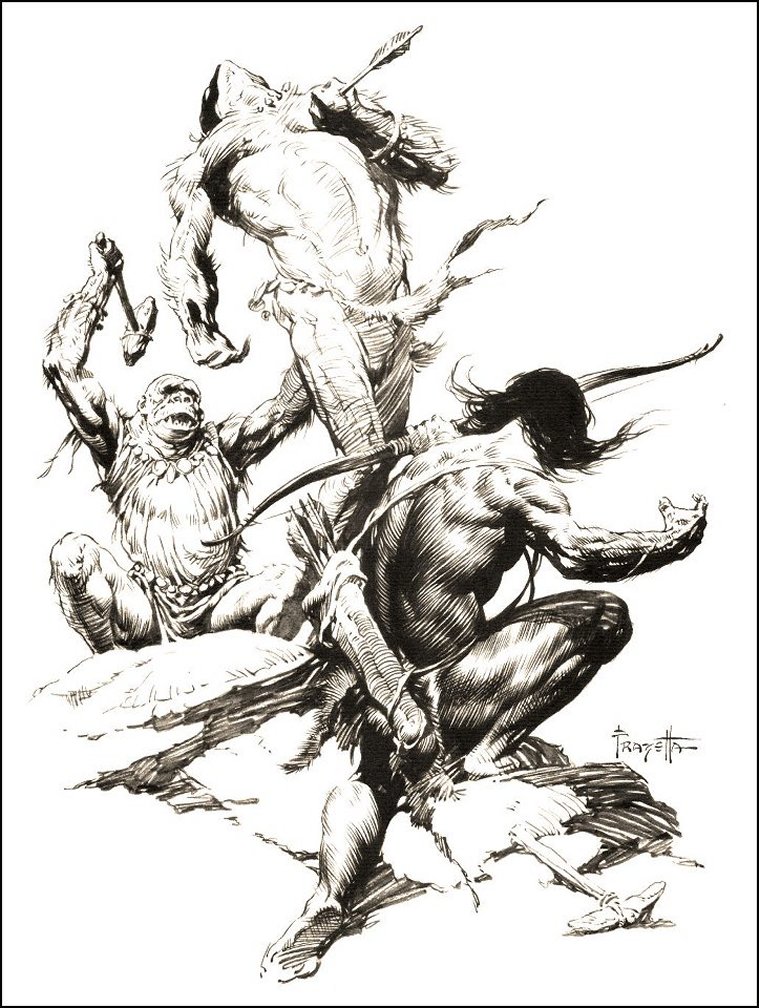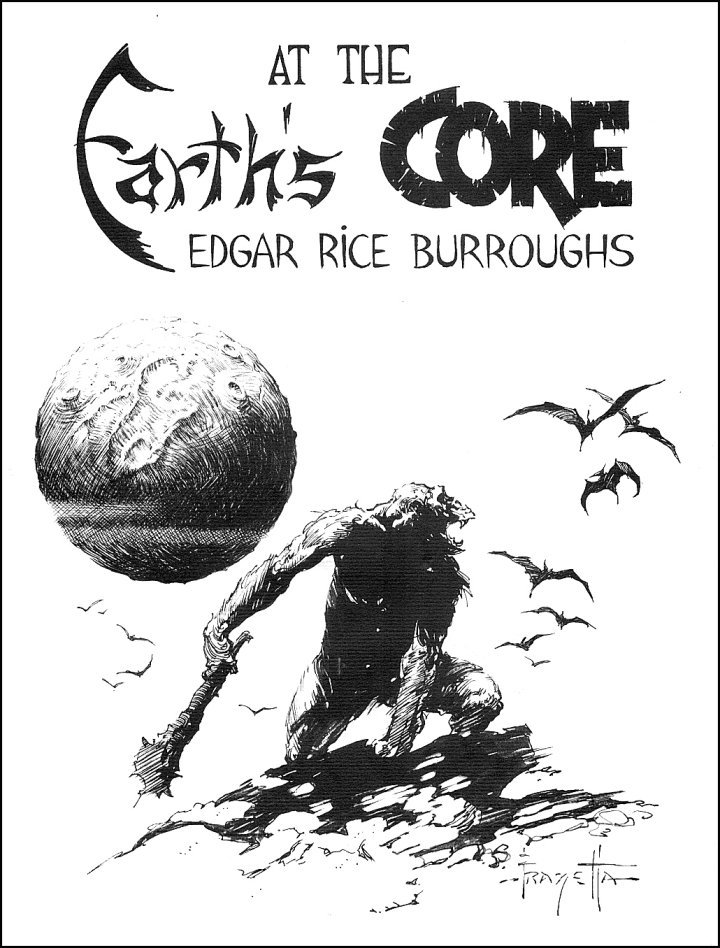Edgar Rice Burroughs’s Pellucidar Saga: Series Wrap-Up
Last week I concluded my book-by-book look at Edgar Rice Burroughs’s Pellucidar novels, the prehistoric world inside the Earth’s crust where the stationary sun eradicates the passage of time. The complete series consists of seven books:
- At the Earth’s Core (1914)
- Pellucidar (1915)
- Tanar of Pellucidar (1929)
- Tarzan at the Earth’s Core (1929–30)
- Back to the Stone Age (1937)
- Land of Terror (1944)
- Savage Pellucidar (1963)
Compared to Burroughs’s other two long-running science-fiction series, Mars/Barsoom and Venus/Amtor, Pellucidar is more difficult to summarize. The Venus novels were written over a short period of time during the end of Burroughs’s career and all feature the same hero, Carson Napier. There are no Venus classics, with the best (Lost on Venus) only middling and the rest ranging from bland to unreadable. The Mars series presents a vast canvas that arcs across Burroughs’s career, but it’s the most consistently high quality of any of his series, including the Tarzan novels, so it’s not too difficult to give it a broad analysis that primarily looks at changes in protagonists.
The Pellucidar books, however, present conundrums when consumed in a short period. Like Mars, Pellucidar spans the major phases of ERB’s career: success in the ‘teens, a stabilizing period in the twenties, a steepening decline throughout the thirties, a World War II revival, and a “lost” story and final volume published posthumously in the sixties. Unlike Mars, Burroughs visited Pellucidar sporadically, with a fourteen-year lapse after the first two paired novels, and later a seven-year gap.
The change in quality in the Pellucidar novels is erratic as well. At the Earth’s Core is a masterpiece; Land of Terror is close to ERB’s worst, with Back to the Stone Age perched only a few rungs higher; Savage Pellucidar is immensely superior in construction and excitement to the Mars and Venus books written at the same time; and Tarzan at the Earth’s Core is a fun pulpy crossover. That the series even has a crossover makes it unique among Burroughs’s science fiction. He linked his novels using a fictional version of himself, whom I call the pseudo-ERB, who reports to readers the tales learned from his various protagonists. But only when Tarzan flew into Pellucidar in an airship did ERB unite two of his worlds for a full story.
Perhaps the most confounding aspect of Pellucidar is that when reading the series in its entirety, it becomes clear Burroughs never planned or wanted to expand the setting beyond the original two novels. Burroughs wrote a number of mini-series that were really single novels published in separate parts: The Mucker, The Moon Maid, The Cave Girl, The Land That Time Forgot. When Burroughs completed At the Earth’s Core, he was in a powerful enough position as a newly successful writer that he could leave the book on a cliffhanger with the story awaiting resolution and know he’d have the opportunity to publish Part 2 within a year. That second book, Pellucidar, satisfactorily concludes the adventures of explorers David Innes and Abner Perry in the inner world. Not only have David and Perry defeated the reptilian overlords, the Mahars, and resolved all the plot strands of the first book, they set about to transform completely the lands of Pellucidar with an extensive modernization program.
 I believe Burroughs meant for it to stop there; it took almost a decade and a half before he wrote another book in the setting. The first three books of the Mars series form a similar complete tale of an outsider’s conquest, but Burroughs waited only a little over a year before he started writing the next Barsoom novel, Thuvia, Maid of Mars, and set out to find new ways to explore the Martian setting. With Pellucidar, he apparently felt he’d taken the story as far as it should go by 1915. He concluded Pellucidar with a vision of the inner world as a Steampunk paradise, then left it the same way he left Caspak and the Moon.
I believe Burroughs meant for it to stop there; it took almost a decade and a half before he wrote another book in the setting. The first three books of the Mars series form a similar complete tale of an outsider’s conquest, but Burroughs waited only a little over a year before he started writing the next Barsoom novel, Thuvia, Maid of Mars, and set out to find new ways to explore the Martian setting. With Pellucidar, he apparently felt he’d taken the story as far as it should go by 1915. He concluded Pellucidar with a vision of the inner world as a Steampunk paradise, then left it the same way he left Caspak and the Moon.
It was repeated readers’ requests that eventually catalyzed Burroughs to go back to his dictaphone to create more Pellucidar adventures. He might have continued to resist fans’ pleas, but he found Pellucidar gave him an opportunity to enliven his flagging interest in churning out Tarzan novels by sending the Lord of the Jungle to the Earth’s Core. Tanar of Pellucidar was written specifically to set up Tarzan at the Earth’s Core (and unfortunately feels exactly like set-up).
Once ERB had re-opened Pellucidar for business, he couldn’t close up shop so easily again. He soldiered onward over the next fifteen years, seemingly as lost as the protagonists of Back the Stone Age and Land of Terror. Creative exhaustion was setting in for the aging author in the 1930s, and his malaise about Pellucidar and what to do with it comes through in the almost plotless meanderings of those two books. (I’ll admit to enjoying Back to the Stone Age more than I once did, but I can’t recommend it to anyone except the Burroughsian faithful.)
When Burroughs was on his game with the three best of these novels (see below for the ranking), the ingenious setting of Pellucidar brought out some of the greatest excitement and ingenuity of his career. At the Earth’s Core, where the mystery of time is the most meaningful and powerful, is an SF masterpiece that I’d rank it among Burroughs’s Top Five if I ever tried to construct such a list. (I won’t because the list would be impossibly fluid.) David Innes is an energetic character whose ambitions of a modern colonial conquest set him apart from Tarzan and even John Carter. The Mahars are among the best creatures, let alone villains, in the ERB canon, and the follow-up novel makes them even more fascinating through biological empathy. It’s unfortunate the Mahars never returned to their starring role, which is one of the big flaws of the overall series. The Korsars did make for enjoyable replacements in Tanar of Pellucidar, even though they’re pretty rotten at the actual sailing part of piracy. Tarzan at the Earth’s Core is quintessential pulp that revives Pellucidar’s strange nature by putting it up against the powers of Tarzan and interfering with them. It’s also a winner for pulse-pounding, savage action — Tarzan is good at bringing that out. As far as end-of-career works go, Savage Pellucidar is intriguing and offers a deep well for analysis. It also stars O-aa, one of ERB’s best heroines, which is a fantastic surprise so deep into a series.
The nature of time and direction in Pellucidar are both its most fascinating and most frustrating elements; I’d argue they’re what made Burroughs reluctant to give the inner earth as many series entries as Mars. There’s no shortage of adventures possible in Pellucidar because of the prehistoric fauna that can include almost any type of beast and the ability to pull in surface-world characters from other parts of Earth’s history, such as the piratical Korsars and the offbeat mid-nineteenth-century Cape Cod cannibal Ah-gilak. The timelessness of the setting, however, created a writing dilemma. It’s difficult to sustain tension and overlapping plots when time cannot be measured in any meaningful way. The later novels fell into a sense of aimlessness as each focused on single heroes moving through linear episodic encounters: Tanar, von Horst, and David Innes once again.
 Even with the excitement of Tarzan at the Earth’s Core, the later books have a sense of drift without tension. Monsters and strange races pop up, but nothing hangs around for long — without time, eventually nothing seems to matter. One of the most inventive aspects of At the Earth’s Core becomes a background detail of the later novels and a hindrance that was infecting the heroes. Land of Terror is the nadir, where David Innes, once the most colonial-minded and optimistic of ERB heroes, stays lost doing nothing while nothing happens.
Even with the excitement of Tarzan at the Earth’s Core, the later books have a sense of drift without tension. Monsters and strange races pop up, but nothing hangs around for long — without time, eventually nothing seems to matter. One of the most inventive aspects of At the Earth’s Core becomes a background detail of the later novels and a hindrance that was infecting the heroes. Land of Terror is the nadir, where David Innes, once the most colonial-minded and optimistic of ERB heroes, stays lost doing nothing while nothing happens.
This is why Savage Pellucidar is such an intriguing finale. Whether intentional or not, the final book lays out a retroactive theme for the series: the futility of civilization-building without the progression of time. Innes and Perry have been in the inner world for more than thirty years when Savage Pellucidar starts — and even this isn’t clear, since there’s no reference to the outer world through a framing device with the pseudo-ERB. During these decades, none of the progress toward an industrialized Empire of Pellucidar that David proclaimed in the closing chapter of the second novel, back in 1915, has been realized. No typewriters, sewing machines, steam engines, colleges, or any of the triumphant vision he planned to construct with the help of Perry’s science. Thirty to fifty years later, almost nothing has been accomplished. Devices to tell time have been destroyed. Perry’s inventions rarely work and nobody appears to want to use them. The people of David Innes’s empire are still at Stone Age levels of both technology and thought, as if nothing has changed at all. This is the theme of Back to the Stone Age at work — a primitive land will turn even the modern human mind back to a Stone Age mentality. Innes and science cannot move Pellucidar forward: it is as much the Land That Time Forgot as Caspak.
Yet David Innes feels no frustration with this in either Land of Terror or Savage Pellucidar. He’s not even resigned to it; it’s simply the reality. This is probably because Burroughs himself was satisfied with Pellucidar this way if he needed to continue writing more novels set there. He could’ve ignored the time issue: at the end of Pellucidar, David Innes discovers a way to create the demarcation of time even with an immobile sun. But in the next novel, David purposely destroys all the clocks and gives Pellucidar back its chrono-subjectivity because its inhabitants couldn’t get accustomed to the idea of time. It’s a shrug at the once magnificent plans of civilization and progress: “Well, that didn’t work. So it’s back to caveman and dinosaur antics.”
That I’m even able to have this type of discussion about a series of lost world pulp novels featuring dinosaurs, savage ape creatures, hyaenodon sidekicks, Tarzan beating up a cave bear, and telepathic super Rhamphorhynchuses is why Edgar Rice Burroughs is one of my favorite authors.
Aside from pointing out problems with individual novels, overall the biggest flaw with the Pellucidar series is that Burroughs didn’t take advantage of more of its opportunities. A trip to the pendant world. More new topside adventurers. The discovery of additional time-trapped civilizations from different eras of earth, similar to the Korsars. A return of the Mahars to wage war against the Empire of Pellucidar. These could all form the basis of fantastic novels. But Burroughs relied repeatedly on an episodic formula that repeats in Tanar of Pellucidar, Back to the Stone Age, Land of Terror, and to a lesser extent in Savage Pellucidar and Tarzan at the Earth’s Core.
Still, when Burroughs used the setting for savage encounters with strange beasts — and Tarzan at the Earth’s Core is top in that field — he delivered the exquisite thrills he’s known for. The continuation of the series past the excellent original duology was worth it for the Tarzan crossover and O-aa alone. It also gave us some of the best animal companions in the ERB canon: Raja the Wonder Hyaenodon, Old White the mammoth, O-aa’s killer wolfhound Rahna, and even Tanar’s snake buddy.
So I come to the end, still finding summarization eluding me with the most unusual of ERB series. Its triumphs are strong enough to make them worthy companions to the finest Mars novels, while its decline creates its own fascination even as it plunges to a career nadir. Perhaps fascination is the best single word summary. No matter what, Burroughs and his worlds fascinate.
The series ranked from best to worst
- At the Earth’s Core
- Pellucidar
- Tarzan at the Earth’s Core
- Savage Pellucidar
- Tanar of Pellucidar
- Back to the Stone Age
- Land of Terror
For a rousing close-out, an unscientific list of the best moments in the Pellucidar saga:
- The Mahars hypnotize and gradually devour human captives inside a watery grotto. (At the Earth’s Core)
- David Innes and the Mahar Tul-al-sa part company, and Innes ponders the role of the Mahars in Pellucidar’s chain of being as she flies off. (Pellucidar)
- Tarzan battles a Pteranodon in mid-air. (Tarzan at the Earth’s Core)
- Only minutes after being captured, O-aa grabs the spear from her kidnapper and immediately runs him through with it. (Savage Pellucidar)
- The newly created Great Navy of Pellucidar arrives at the climax to rescue David Innes. (Pellucidar)
- Airship O-220 passes through the polar entrance into Pellucidar. (Tarzan at the Earth’s Core)
- The initial iron mole drilling disaster that opens the saga, complete with Perry swearing at the malfunctioning machinery. (At the Earth’s Core)
- The mammoth Old White rescues von Horst from an arena death among sabertooths, hurling a few of the creatures into the watching crowd. (Back to the Stone Age)
- David Innes imagines the Empire of Pellucidar remade as a modern industrial society. (Pellucidar)
- A stampede of seemingly all prehistoric life on Pellucidar scatters the search party from the O-220. (Tarzan at the Earth’s Core)
- Jason Gridley makes fun of Edgar Rice Burroughs’s plotting style. (Tanar of Pellucidar)
- Dian sics three sabertooths on a man who hoped to forcibly seize her. (Savage Pellucidar)
- Jason Gridley finds Tarzan in the jungle and delivers a message to him from Tarzan’s own creator. (Tarzan at the Earth’s Core)
- David rescues a wolfhound from drowning and develops a dedicated sidekick, Raja. (Pellucidar)
- The first discovery of the polar opening from Pellucidar to the outside world. (Tanar of Pellucidar)
- Jason Gridley opens fire with revolvers on a pack of hyaenodons while trying to save Jana from her pursuers. (Tarzan at the Earth’s Core)
Next: I’ll stay with Ed during the last phase of his career, Beyond the Farthest Star.
Ryan Harvey is one of the original bloggers for Black Gate, starting in 2008. He received the Writers of the Future Award for his short story “An Acolyte of Black Spires,” and his stories “The Sorrowless Thief” and “Stand at Dubun-Geb” are available in Black Gate online fiction. A further Ahn-Tarqa adventure, “Farewell to Tyrn”, is currently available as an e-book. Ryan lives in Costa Mesa, California where he works as a professional writer for a marketing company. Occasionally, people ask him to talk about Edgar Rice Burroughs or Godzilla in interviews.

Thanks for taking us on this tour.
I’ll second that — this has been a great series of posts.